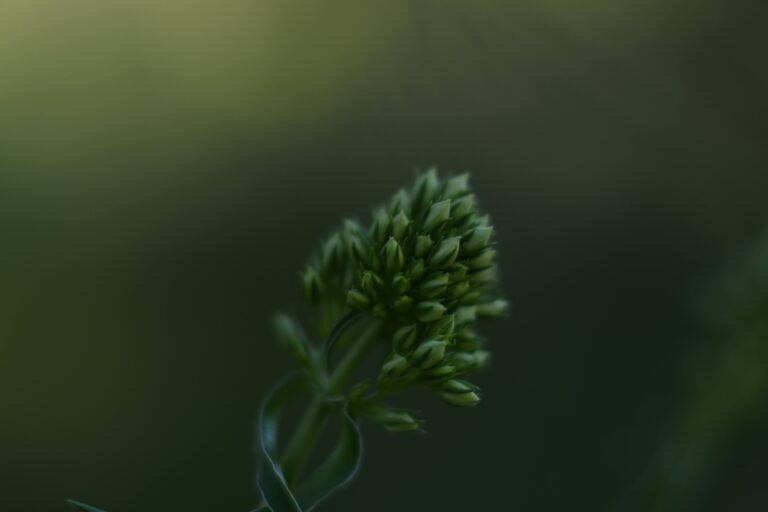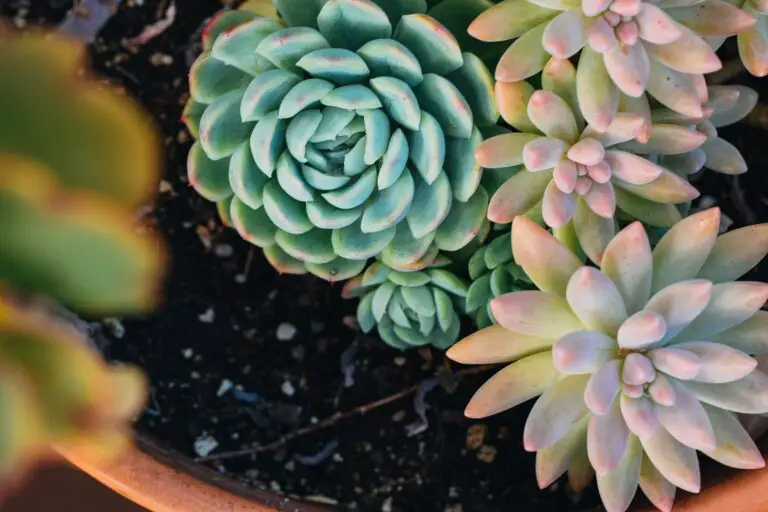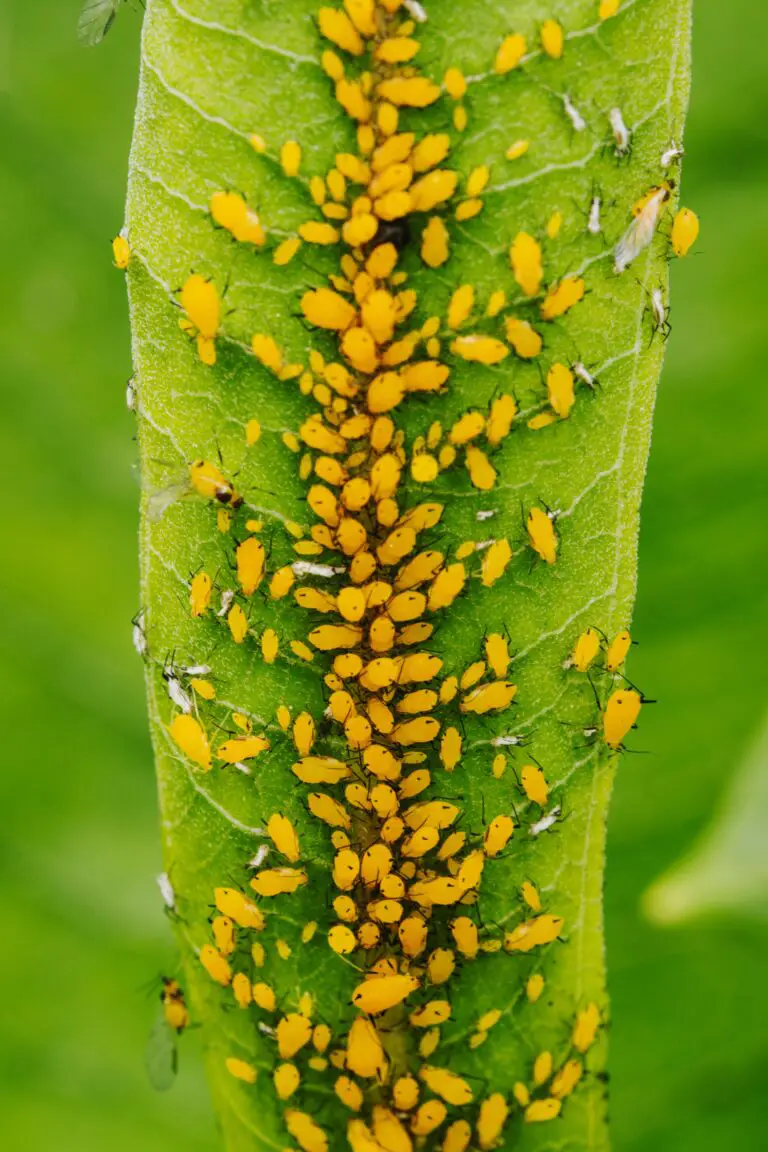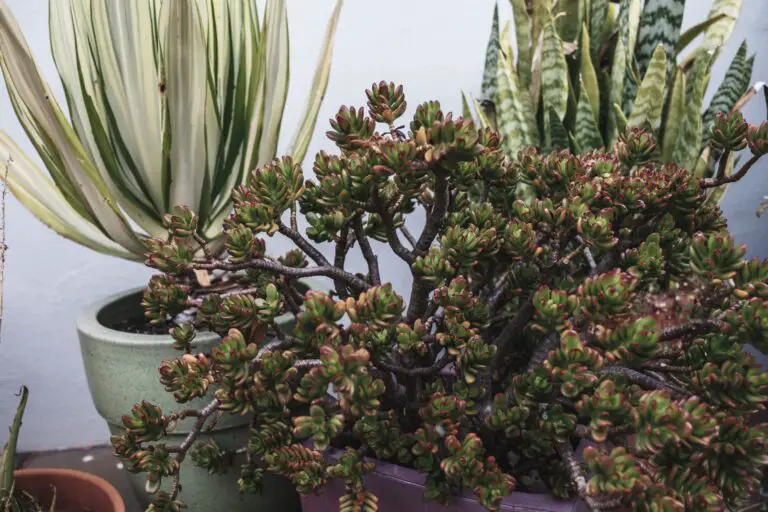Introduction to John Creech Sedum
Enticing the eyes and easing the gardener’s task, John Creech Sedum is a living tapestry for any landscape artist or hobbyist gardener. Originating from the highlands of Asia, this robust perennial brings a flush of greenery and vitality to the table—or rather, the soil—of your garden oasis. But what makes this groundcover not just a botanical wonder, but a favorite among the green-thumbed community?

Botanically speaking, John Creech Sedum captivates with its hardy nature and seductive, mat-forming sprawl. Its petite, scalloped leaves cluster together, crafting an evergreen quilt that thrives from spring’s first whisper to the chill breath of late autumn. When the air starts to crisp, delicate pink flowers crown the foliage, turning heads and inviting an audience of pollinators.
Why gardeners whisper its praises is no mystery once you witness its resilience. Tolerant of drought and negligent watering habits, it asks little but delivers much. Imagine a plant that braves the summer heat, yet gracefully weaves its way through colder months, requiring not a blanket nor a shelter. It’s a plant that embodies the philosophy: less is more—and who doesn’t cherish a low-maintenance relationship with nature?
Peek into any gardener’s journal or peruse our thorough guide on the ultimate care for succulents, and you’ll likely find the John Creech Sedum gracing the pages. It doesn’t beg for the limelight but rather plays a supporting role, making everything around it shine a little brighter. It’s this unpretentious charm and stoic beauty that renders it an invaluable jewel in the crown of any garden arrangement.
Botanical Profile of John Creech
Let’s dive right into the verdant world of John Creech sedum, whose botanical splendor has bedazzled many a garden enthusiast. At first glance, you might just appreciate its lush, low-growing mats of vibrant green, but there’s so much more to discover about this fascinating plant.
Remarkable for its tenacity, John Creech sedum boasts a growth habit that’s as resilient as it is charming. Picture this: tiny, densely packed leaves knitting together a tapestry of flora that softens rockeries and creeps calmly across garden borders. Its ability not to flinch in the face of drought tests speaks volumes about its hardy character, making it a must-have for those challenging, sun-soaked spots in your garden.

No botanical portrait would be complete without evoking John Creech’s foliage, each leaf a masterpiece of nature’s design. Emerald in the growing season, the sedum’s leaves can take on a reddish hue as colder weather sets in, adding yet another layer of visual intrigue to your green space.
And come summertime, this sedum elevates itself from mere ground cover to a carnival of star-shaped, pink flowers. When they bloom, it’s as though your garden has donned its festive attire, a spectacle that invites local pollinators to partake in the bountiful spread. The flowers aren’t just pretty faces either; they serve a greater environmental narrative by drawing in the birds and the bees, ensuring your personal Eden is a hub of natural activity.
If you’re seeking advice on how to nurture this verdant jewel, cherish the wisdom doled out on personalized care for sedums. With just the right sunlight, water palette, and generous attention, your John Creech will thrive.
For those avid for even more succulent insights, explore our comprehensive guide on succulent care. Leave no leaf unturned as you embark on your journey to cultivate a thriving garden oasis dotted with succulents as vibrant as the John Creech.
Optimal Growth Conditions
Welcome to the world of John Creech Sedum, a dynamo of stability and color for any garden enthusiast! Now, let’s deep-dive into the pursuit of perfection for these tough little plants. It’s not just about plonking them in some dirt and hoping for the best. No, these succulent superstars thrive under specific conditions, and I’m going to unfold these secrets for you.
First up, sunlight. It’s like the golden ticket for the John Creech Sedum. They love the sun, basking in at least six hours of the bright stuff daily. Imagine them sunbathing by the pool, soaking up the rays. That said, they’re not vain – these plants can do pretty well in partial shade too, a testament to their flexibility.
Next, let’s talk dirt – soil, to be exact. These Sedums prefer well-draining soil. Think about making a home that’s comfy yet sturdy, like a cozy cottage with a solid foundation. You want to avoid waterlogged soil like avoiding a swampy nightmare. If your garden bed is the captain of a ship, you don’t want it sinking.
We can’t forget about climate. While they’re cold-hardy, thriving in USDA zones 3 through 9, they don’t like to have wet feet. Cold, wet soil in the winter is a one-way ticket to a droopy, unhappy Sedum. You’d much prefer a pair of warm, dry socks, right? Well, it’s the same for these green goddesses.
Let’s take a moment to divert our gaze to a realm of unlimited succulent care knowledge provided by our comprehensive guide to succulent care. Here, you can expand your gardening wisdom beyond the scope of our resilient John Creech friend.
Remember, achieving these optimal conditions isn’t just about ticking boxes. It’s about marrying the elements to create a harmonious environment where the John Creech Sedum doesn’t just survive; it flourishes, spreading joy with its evergreen foliage and pinkish-purple flowers. A little attention to detail goes a long way in nurturing a garden oasis that becomes the envy of the block.
Real Examples from a Real Garden
To put this into perspective, let’s materialize these tips into a true success story. Picture Sarah’s suburban backyard in sunny California. She adjusted her slightly clayey soil with sand and organic matter to achieve that perfect drainage and aeration. Her John Creech clan is positioned on a gentle slope, grasping the sunlight with open leaves and rewarded with a kaleidoscope of colors that burst forth in the growing season.
Or take the example of Mark, hailing from the chillier climes of Vermont. He uses a raised bed to ensure his Sedums steer clear of the soggy soil dilemma brought on by snowmelt. His strategic positioning near a south-facing wall grants extra warmth and light, fostering a mini ecosystem where his Sedums can sing winter’s blues away.
Want to see these beauties in action? Feast your eyes on this video showing John Creech Sedum covering ground like green royalty:
Landscape Design Ideas with John Creech Sedum
Welcome to the lush world of John Creech, a versatile and vibrant sedum that can elevate your garden into a verdant paradise! This hardy groundcover sedum has a knack for fitting into various landscape designs with unparalleled charm and true survivor’s resilience. So let’s dive into some creative landscapes where John Creech steals the show!
Imagine a quaint rock garden, with sun-kissed nooks between stones that beg for a touch of life. John Creech fills these spaces with ease, its verdant mats spilling over, softening the hard edges, and creating a tapestry of greens that’s a feast for the eyes. Use this green jewel to harmonize your rocky landscape, painting a picture that’s nature-perfected.
For those of us with an incline in our yards that is more of an eroding challenge than a landscape feature, John Creech comes to the rescue! Its tenacious roots and spreading habit make it an excellent candidate for stabilizing slopes, and its dense coverage fends off weeds that might otherwise take hold. Plus, you won’t be tussling with the lawnmower on that precarious angle anymore!
Bordering paths or defining the spaces around them can be transformed with this stonecrop. Envision a footpath lined with billowy sedums, their pink blooms nodding as you stroll past. Not only does John Creech add a whimsy to your walkways, but it’s also famous for being remarkably foot-traffic tolerant. Whether it’s framing a garden path or offering a green handshake at your doorstep, it’s a winning choice for ground-level greetings.
Lastly, let’s not forget container gardening – an urban gardener’s best friend. John Creech, with its shallow root system and drought tolerance, thrives in pots and planters. Craft a succulent arrangement with this sedum as a verdant base – its vibrant greenery can make other colors pop! Combine it with other succulents or flowering perennials for a display that sings through the seasons.
To top off your inspiration, here’s an amazing guide on growing sedums that can illuminate your next garden project with practical tips and insightful advice.
Whether it’s rockeries, slopes, borders, or pots, John Creech Sedum fits in just like it belongs – ever green, ever serene, and ever so ready to turn your landscape dreams into reality!
Overcoming Common Pests and Problems
If you’ve welcomed the resilient and vibrant John Creech Sedum into your garden, you’ve made a green-thumbed choice that promises an eye-catching display with minimal fuss. However, even the hardiest of plants can sometimes play host to nefarious garden nemeses. Below, we’re going to dig into the gritty details of the pests and problems your John Creech Sedum might face and arm you with the green wisdom needed to keep these troubles at bay.
First up in the rogue’s gallery are aphids, those pesky, sap-sucking insects that can turn your sedum’s leaves into their personal juice bars. Be alert for the first sign of sticky residue or misshapen and yellowing foliage, both telltale signs of an aphid invasion. But don’t despair; with a swift response using insecticidal soap or a potent spray down from your garden hose, you’ll wash away both the aphids and your worries.

Next, we come across the villainous spider mites, micro marauders that are tinier than a speck of dust yet can cause a world of trouble. Caught in the act by the fine, silken webs on the undersides of leaves or by foliage that looks suspiciously faded, spider mites are no match for neem oil or a forceful stream of water. Keep an eye out during hot, dry weather, as these conditions are prime time for spider mite shenanigans.
We can’t talk about sedum woe without mentioning root rot, the dastardly result of an overzealous watering can or poor drainage. Your first clue might be wilting leaves or stems that are softer than your favourite marshmallow. Prevention is key here: Make sure your John Creech Sedum is planted in well-draining soil and be mindful of the soggy dangers of overwatering. If your sedum is already singing the blues, try repotting it in fresh soil with better drainage and adjust your watering habits.
Using real-life scenarios to emphasize the plight, imagine your John Creech Sedum as the underdog in an epic battle against fungal foes like powdery mildew. This ghostly white coating on the leaves and stems can be a pain but is far from invincible. Increase air circulation around your plants, and at the first sight of trouble, apply a baking soda and water mixture to send the mildew packing.
Remember, vigilant guardianship against these common foes is essential for keeping your John Creech Sedum thriving in the lush haven of your garden. With the right knowledge and quick action, you’ll ensure that these pesky problems are merely footnotes in the success story of your garden oasis.
Environmental Impact and Sustainability of John Creech Sedum
Picture this: a lush garden that thrives with minimal water, resists pests without chemicals, and adds a carpet of vibrant green to your outdoor sanctuary. This isn’t a fantasy; it’s the reality when you invite John Creech Sedum into your landscape.
John Creech Sedum is not just another pretty face in the garden; it’s a champion of eco-friendliness. Its drought-tolerant nature means you can save on water consumption, a resource that’s becoming increasingly precious, while still enjoying a verdant garden year-round. This hardy succulent is like a mini oasis in itself, supporting insects and providing ground cover that reduces soil erosion, making it an ally in the battle against climate change.
Teaming Up for a Greener Tomorrow
When it comes to sustainable landscaping, John Creech Sedum is a groundbreaker—quite literally. It requires far less maintenance than traditional turf grass, reducing the need for fossil fuel-powered lawnmowers and trimmers. And because it’s remarkably resilient, it significantly decreases the temptation to use harsh pesticides. A garden featuring John Creech Sedum is a haven for pollinators, attracting bees, butterflies, and other beneficial insects, promoting biodiversity right in your backyard.
Think of John Creech Sedum as your green partner in the quest for a sustainable future. By incorporating it into your garden, you’re contributing to a larger movement towards environmental stewardship. Imagine neighborhoods connected by these green corridors, where John Creech Sedums serve as a natural tapestry, weaving ecosystems together and providing a mosaic of habitats.
Companion Plants for John Creech Sedum
Creating a tapestry of textures and hues in your garden is a joy unto itself, especially when you have a plant like John Creech Sedum as the star of the show. This hardy succulent provides a lush, green backdrop against which the rainbow of companion plants can shine. But what are the best co-stars for this versatile ground cover? Let’s roll out the green carpet and introduce the ensemble.
First up are the delightful Catmint (Nepeta) varieties, with their frothy lavender blooms dancing in the breeze alongside the John Creech Sedum. Not only do they bring a whimsical charm to the garden bed, but their minty fragrance is a delight on a warm summer day. Then there’s the classic Lavender (Lavandula), whose silvery foliage and purple spires provide a contrast in both texture and color, making for an eye-catching duo.
If it’s drama you’re after, look no further than the ornamental grasses like Blue Fescue (Festuca glauca). With its blue-green blades, it sways gracefully in the wind, offering a dynamic display of movement next to the low-growing John Creech Sedum. And let’s not overlook the humble yet striking Dianthus, with its spiky green foliage and sweetly scented pink blossoms that seem to float above the sedum.
Avid gardeners will tell you that no garden party is complete without guests that attract butterflies and bees. Enter the Butterfly Bush (Buddleia davidii), a nectar-filled haven for fluttering friends, standing tall and proud beside the sedum’s carpet of green. And for those who appreciate the bees’ buzz, the bright and sunny Black-Eyed Susan (Rudbeckia) is the perfect pairing, offering a buffet for these vital pollinators.
When the leaves start to fall, and the chill sets in, the John Creech Sedum’s steadfast presence is complemented by the warm tones of Autumn Joy Sedum (Hylotelephium ‘Herbstfreude’), whose rosy flower heads echo the warmth of the season. It’s a pairing that reminds us of the garden’s ever-changing nature, yet constant beauty.
Lastly, consider the vibrant pops of color from annuals such as Pansies (Viola x wittrockiana) or Marigolds (Tagetes), which provide an ever-evolving palette of colors to keep your garden oasis looking fresh and lively throughout the seasons.
By choosing any of these companion plants, you ensure that your John Creech Sedum shares the spotlight with a diverse cast, each enhancing the other’s beauty and creating a living, breathing masterpiece right in your backyard.

Frequently Asked Questions about John Creech Sedum
Got questions about the ever-so-vibrant John Creech Sedum? You’re in the right place! Whether you’re a green thumb guru or just starting to dip your toes in the garden pond, this section’s got your back. Let’s jump right into the dirt and dig up some answers!
How do I make sure my John Creech Sedum thrives?
It’s simpler than you might think! Imagine a rockery bathed in sunlight, that’s the perfect hangout spot for your Sedum. These succulent beauties love the sun and well-drained soil. Just envision a Mediterranean garden—rocky, sunny, and breezy, and that’s precisely what your John Creech aspires to call home.
What’s the secret to propagating these succulents successfully?
Think of it as plant parenting; it’s all about nurturing and providing the right environment. With John Creech Sedum, it’s like magic—snip a piece, let it callous, pop it in some soil, and voilà, baby sedums will appear! It’s like turning one plant into an entire family without needing a Hogwarts degree.
Can I use John Creech Sedum in different garden settings?
Oh, absolutely! Picture this: a charming rock garden where your sedum creates a lush green carpet, or a fairy-tale terracotta pot on your patio with a cascade of these hardy stars. They’re versatile, drought-tolerant, and will add a touch of low-maintenance elegance wherever they grow.
Imagine a low-border along your walkway with John Creech waving at your neighbors, or as an unexpected hero in a vertical garden, standing tall and proud. It’s all possible!

So there you have it, folks! Whether you’re looking to transform your yard into a sedum sanctuary, or simply want a little green buddy on your desk, John Creech Sedum is the resilient charmer you’ve been searching for. Go ahead, give it a try, and watch your garden (and your green thumb cred) bloom!



